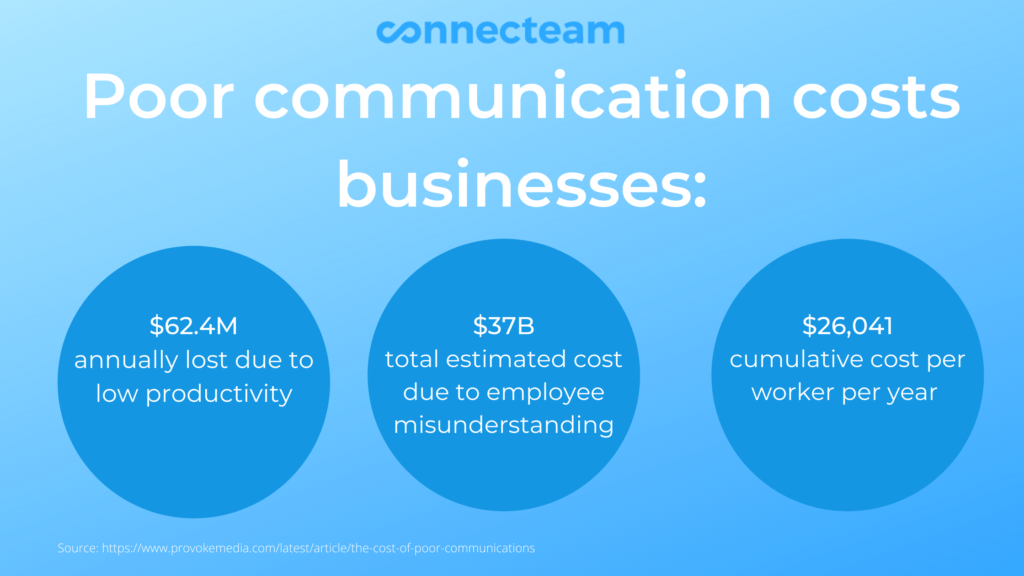Let’s take a look at some of the main internal communication problems and how you can easily overcome them, in turn boosting employee engagement, motivation, and productivity.
While effective internal communication is critical for the success of any company, it’s often overlooked. Poor communication in the workplace can, therefore, quickly pave the way for misunderstandings, low morale, decreased productivity, and even legal issues.
Recognizing and addressing internal communication issues allows you to foster a culture of transparency, collaboration, and engagement, leading to improved performance and increased employee satisfaction.
Let’s get right to it and explore 7 common workplace communication issues and practical solutions to overcome these communication challenges, allowing you to level up your internal communication strategy.
But first:
Why Is Good Workplace Communications Essential?
Good communication is the number one rule in any healthy relationship, including those with your employees.
In a nutshell, effective internal communication is key to good employee productivity, cooperation, and efficiency. It allows you to set clear expectations and empower your staff to perform their jobs without guesswork or unnecessary back and forth, saving time, mistakes, and frustration.
On top of that, openly and regularly communicating with your staff has proven to boost employee morale and enhance engagement. This, in turn, improves job satisfaction and retention rates.

7 Common Communication Problems and Solutions
Before getting to the good part, let’s first take a look at where workplace communication typically goes south.
Problem: Communication barriers
While communication barriers come in many shapes and sizes, they all form obstacles to sharing or receiving information. They include:
- Physical boundaries, such as for remote and field teams
- Colleagues working different schedules
- Lack of communication channels or tools
- Language or cultural barriers
These barriers make it difficult for employees to collaborate, share ideas, and stay aligned on organizational goals. This can, in turn, negatively impact productivity, employee morale, and, ultimately, your bottom line.
Solution: Implement communication tools
The first step in overcoming communication barriers is to invest in effective internal communication tools that support instant, effective, and transparent communication.
Employee communication app keep you and your team connected, regardless of their location or work hours. They allow employees can instantly communicate, collaborate, and stay up-to-date on the latest company information, which can further help build stronger relationships among team members and boost their feeling of connectedness to your company.

Problem: No clear line of communication
Without a clear communication chain or understanding of who is in charge of what and who answers to whom, your employees are uncertain who they should turn to with any questions or concerns. This communication issue in the workplace creates a general lack of accountability and confusion.
Not having a clear line of communication also makes effectively communicating top-level information to your workers challenging.
Solution: Create clear communication structures
Establish a clear line of communication within your company and for your projects. Defining who is responsible for what and who answers to whom creates accountability and clarity. Your workers will know who to turn to for all the information and guidance they need to perform their tasks well. At the same time, you’ll be able to effectively pass down information to your entire workforce without missing anybody.
Problem: Assumption of understanding
Workplace misunderstandings often come from managers or team members assuming that their coworkers are approaching a task or project the same way they would, rather than clearly defining how each step should be done and by which team member. The same counts for assuming their understanding of something you already explained once before.
This goes hand in hand with the assumption that your employees fully understand the information they are given and don’t have any questions, comments, or feedback.
All of this can lead to confusion and tasks being completed insufficiently.
Solution: Provide clarity
Communicate information, instructions, expectations, and responsibilities clearly and concisely. Use simple language and provide written instructions or summaries for your team to look back on when needed.
Also, explaining a task’s importance and how it fits into the bigger picture makes employees feel more valued and motivated. You can even admit that less significant tasks still need to be done to show transparency, build trust, and improve employee engagement and performance.
Encourage your employees to ask questions or for clarification when necessary. You can do this by asking employees if something needs clarification, having them repeat instructions, or gathering feedback.
Problem: Lack of feedback
Without giving your employees feedback on how they are performing regularly – especially if they need to wait an entire year for their annual performance review – your staff will feel left in the dark, undervalued, and disengaged.
It further leads to a lack of employee development, repeated mistakes, growing frustration, poor work morale, and increased employee turnover.
Solution: Provide regular feedback
Don’t wait a year to sit down with your employees, review their performance, and hear how they are doing. Instead, provide them with regular feedback on a weekly or monthly basis.
Be sure to offer both positive and constructive feedback and be specific and objective. Such meetings are also an excellent opportunity to discuss priorities, set goals, and determine if your team has enough time, resources, and information to perform well.
This helps employees understand how they are performing, identify areas for improvement, and feel valued and engaged while promoting a positive work environment and reducing turnover by 30%.

Easily Keep Your Workplace Communication Game on Point
Keep your team engaged and connected, no matter where they are working from, using Connecteam’s employee communication app.
Problem: Information overload
Companies can overshare information with their entire workforce that is only relevant to specific departments, job locations, or seniority levels. This can overwhelm your employees and makes it harder for them to catch or filter out information that is relevant to their day-to-day.
Information overload can further lead to stress, decreased productivity, missed deadlines, mistakes, and burnout, negatively impacting the overall success of your company.
Solution: Focus your flow of information
Be sure to target only the relevant employees with your messaging – whether this is an individual, team, department, or your entire company. This way, your important messages reach all the right people without getting lost in irrelevant messaging.
You can best do this by using a workplace communication tool. An employee communication app like Connecteam for instance allows you to send targeted updates and messages to specific users, for example, based on users’ job titles or locations. Ensure no one misses an important update by sending instant notifications and pinning important content to the top of their feed.
Problem: One-Way Communication
When communication flows only in one direction – without the opportunity for your staff to share their input and feedback – employees quickly feel disconnected, undervalued, and demotivated. This communication problem, in turn, negatively impacts employee productivity, retention rates, and the company culture.
On top of that, one-way communication makes way for misunderstandings and errors. Employees may not fully understand or have the opportunity to clarify the information communicated, leading to delays, mistakes, and even accidents.
Solution: Encourage open communication
The manager should not be the one to do all the talking.
Building a two-way communication relationship with your team and showing them that you value input through regular check-ins, feedback sessions, and surveys is vital. As their manager, you should actively listen to employee feedback and concerns and take appropriate action where necessary.
Fostering a culture of open communication and transparency will allow you to build trust and create an environment where each employee feels comfortable expressing their ideas, asking questions, making suggestions, and raising concerns.
Read our guide on Transparent Communication in the Workplace: How to Create a Culture of Openness
Research further backs up that by having an open-door policy, you can gain “accessibility as a manager, to encourage an open flow of communication, to gain fast access to important or just happening situations or information, and to maintain closer working relationships with employees.”
Problem: Poor knowledge-sharing
When different departments, teams, or even individuals work independently from one another, they often don’t share information. This often leads to inefficiency, duplication of work, missed opportunities for collaboration, and even errors due to incomplete or inaccurate information.
Similarly, storing company knowledge in various locations or formats makes it difficult for your staff to quickly find and access the necessary information. As a result of this communication issue, employees can get frustrated, waste time, and even make mistakes by using outdated or incorrect materials.
Solution: Make company knowledge accessible
To solve this communication problem in the workplace, encourage a culture of knowledge sharing, make it easy for your employees to collaborate, and centralize company knowledge in one accessible location.
Implementing an internal communication and knowledge management system is a great way to do this. This makes it easy for your entire workforce to instantly reach and collaborate with all the right people and directly access the information they need from anywhere in just a few clicks. A great example of such a platform is Connecteam’s employee app.
Download your FREE guide on “10 Tips for Engaging Your Frontline Teams” ⤵

Improve Workplace Communication with Connecteam
Connecteam is an all-in-one employee communication app that offers a comprehensive solution to any internal communication issues. The app is designed to streamline communication between employees and managers, improve collaboration, and facilitate knowledge sharing.

Here are a few examples of how Connecteam can help overcome communication issues in the workplace:
- Two-way communication: You and your staff can instantly communicate with all the right people via the in-app chat. Customizable surveys further allow you to gather your team’s feedback and ideas. This enables you to foster a culture of open communication, boost collaboration and engagement, and make your employees feel valued and heard.
- Targeted messaging: Create channels for specific departments, teams, or projects. This ensures that communication is targeted and relevant, reducing the risk of miscommunication or confusion.
- Knowledge sharing: Share and centralize all up-to-date company information in your in-app knowledge base. From here, your employees can find and access all the information they need to perform their job right from their mobile phones.
- Task information: Easily create and assign tasks with all relevant information, forms, or checklists your team members need to get right to work. This way, your employees have all the information they need at their fingertips, improving productivity.
The Bottomline on Workplace Communication Problems and Solutions
We’ve discussed several ways in which you can solve internal communication challenges. The most important is to use the right communication tools and technology to overcome these challenges and help you go above and beyond. On top of that, the secret formula is to stay consistent in your communication efforts, hold regular meetings, ensure that communication flows in both directions, and make your employees feel valued.
With these tools and tips, you can quickly improve your company’s internal communication, increase employee engagement, boost employee morale, and drive employee productivity.
Introducing: The Modern Employee Communication App
Reinvent communication & engagement in your organization with Connecteam’s communication tools.


